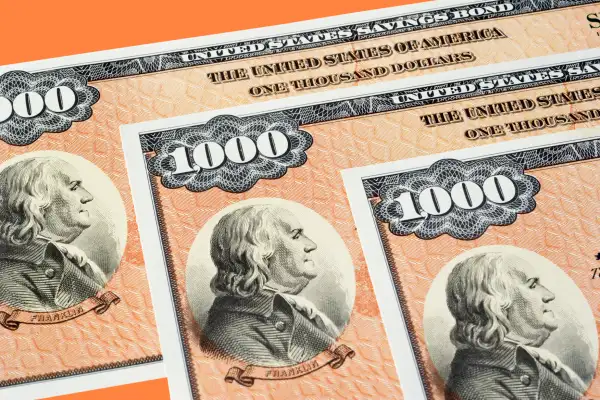Remember Savings Bonds? The Infamous Childhood Birthday Gift Is a Hot Investment Again

Remember your fifth birthday? After unwrapping a small mountain of Legos and a Furby, your grandparents handed you an odd piece of paper, promising 20 years from now that "savings bond" would be worth twice as much. Then you promptly forgot about it. Well get ready, because bonds are back, baby!
… Sort of.
Government savings bonds never left of course. It’s just that their payout was so pitifully low that they lost their appeal. Now, though, those rates are starting to look a bit more attractive.
The Department of Treasury announced on Monday that Series I savings bonds will earn a composite rate of 3.54% over the next six months (up from 1.68%) and Series EE bonds will continue to earn 0.10%, both tracking inflation. Rates for savings bonds are adjusted every six months, so while the timing of the announcement is typical, the increased inflation rate for Series I bonds is a major signal of economic growth.
“The fear right now among investors is inflation,” says Mark Struthers, a certified financial planner at Sona Wealth in Minnesota, “But inflation because economies are growing is a good thing. We’re reflating the economy back to pre-COVID and even beyond that.”
Since 5-year-old you likely didn’t pay attention to the bond you were gifted, here’s a quick breakdown: A Series I bond is a savings bond that earns interest based on the combination of a fixed rate that stays the same for the life of the bond — the current fixed rate is still at 0% — and a variable inflation rate, which is adjusted every six months. Interest is earned every month and then compounded twice a year, with the previous six months’ interest added to the principal amount and then interest for the next period calculated based on that new principal amount.
During periods of economic growth, it can be a great deal: In theory, investors can basically double or even triple their money over the course of 20 to 30 years. But over the past nearly-two decades, I bonds have struggled to attract investors because, as Struthers puts it, “the return on them has been awful,” with fixed rates below 1% since 2007 and minimal returns from inflation.
Similar to I bonds, Series EE savings bonds earn interest on a monthly basis, which is then compounded semi-annually. However, EE bonds have fixed interest rates (as of 2005) that are similar to what you might find in a bank savings account at the time of purchase. With the national interest rate for savings accounts currently at .06%, today’s EE bond rate actually offers higher returns than a typical low-yield savings account.
Both types of savings bonds are different from the bonds in any mutual funds you might own, like those in your IRA or 401(k).
Struthers believes savings bonds get an unfairly bad rap, despite the fact that their returns are not that different than the current average 5-year Certificate of Deposit (CD) rate of 0.34%. They’re nowhere near as sexy as recent investing frenzies like cryptocurrency or meme stocks, with minimal rates of return compared to what a person might earn if they luck out on the stock market.
But there’s a reason your grandparents found savings bonds to be an appropriate gift for a child: they’re an incredibly safe investment.
Although the returns haven’t been anything to write home about, you can’t actually lose money that goes into an individual savings bond. If you buy a $1,000 Series I bond, at best you could end up doubling or tripling the amount by the end of its 30-year term and at the very worst you’ll get $1,000 back that has less buying power than before.
In the case of EE bonds, their fixed rate guarantees that your investment will double over the course of 20 years. Plus, the only penalty you can incur with either type of bond is having to give up the last three months’ interest if you redeem a savings bond less than five years after purchase.
“The biggest reasons people invest in savings bonds are safety and simplicity," Struthers says. "They’re backed by the federal government and can be used as a set-it-and-forget-it type of investment.”
Savings bonds can be especially attractive to parents and relatives of children for future college bills. Taxpayers below a certain income threshold (this changes year to year) can exclude all or part of the interest from their taxes when they redeem the bonds for their child’s higher education expenses like tuition and housing.
“It’s an option that’s under-utilized,” Struthers says, especially in the case of I bonds. “People don’t like seeing the zero, they don’t like uncertainty. But for college funding especially, I think they’re a compelling option.”
Ideally, Struthers says, you would pay for college using savings bonds in combination with other financial tools: “A Roth IRA is the best as a dual purpose account for college and retirement, followed by a 529 college savings plan.” (Roth IRAs and 529 plans also offer tax-free withdrawals for college-related expenses.)
Those accounts, in conjunction with I bonds, can help families avoid taking out student loans to cover sky-high education costs and minimize their tax burden, according to Struthers.
So should you go out and put all of your money into Series I savings bonds? Of course not. As with all investments, it’s essential to diversify your portfolio if you want to maximize your chances of making more money. Future inflation rates are also not easy to predict, so there’s no guarantee that your investment will look all that different when you cash out. But as far as low-risk investments go, right now is not a bad time to test the waters of government savings bonds.
“If we do get inflation, there’s at least a chance [you’ll make money],” Struthers says. “It’s risk-free and if you cash out early, it’s only a three month penalty.”
More from Money:
5 Essential Money Moves for May
Child Tax Credit 2021: Everything to Know About Eligibility, When Monthly Payments Start and More
How to Make a Strategic Spending Plan for Your 529 College Savings

